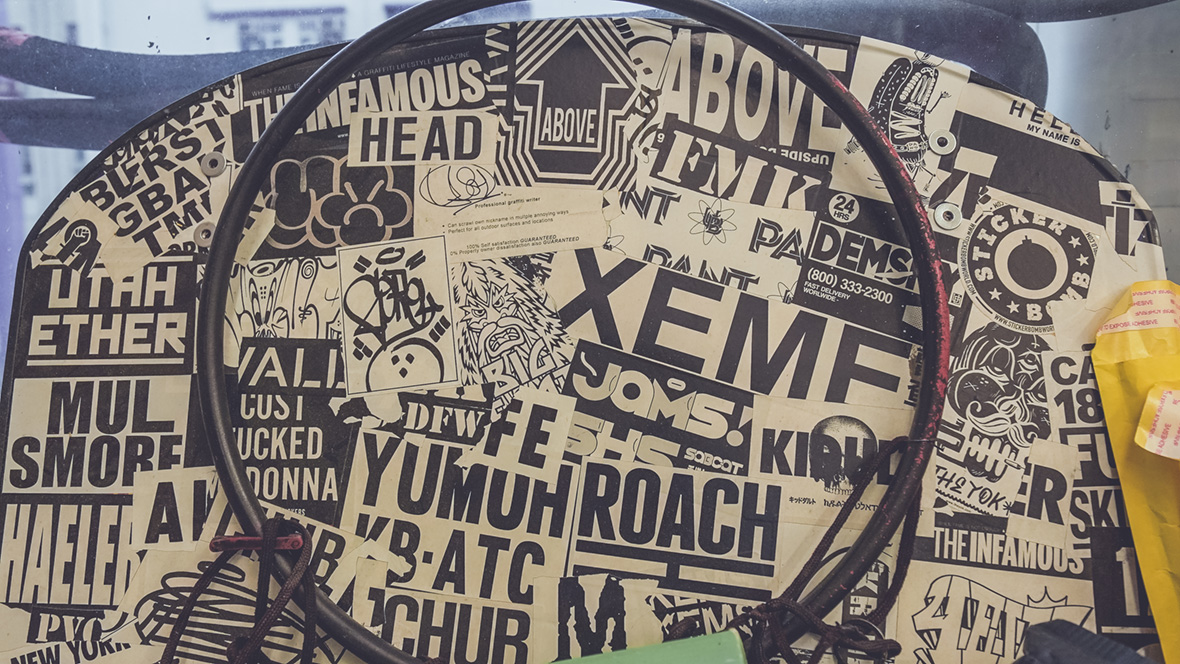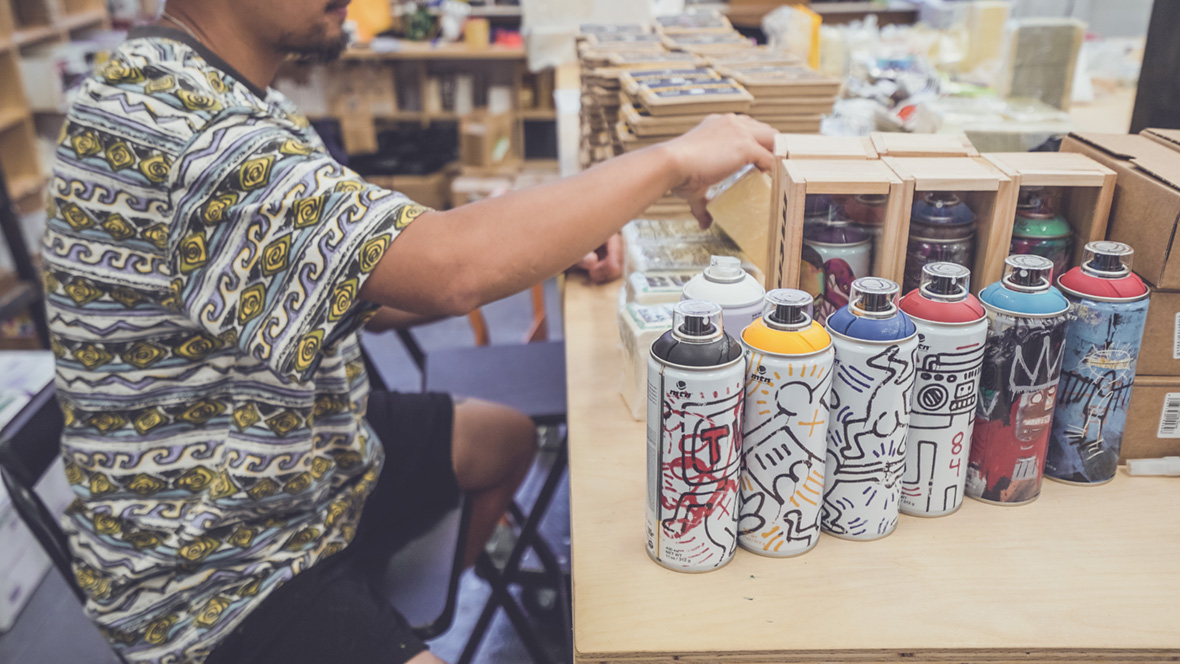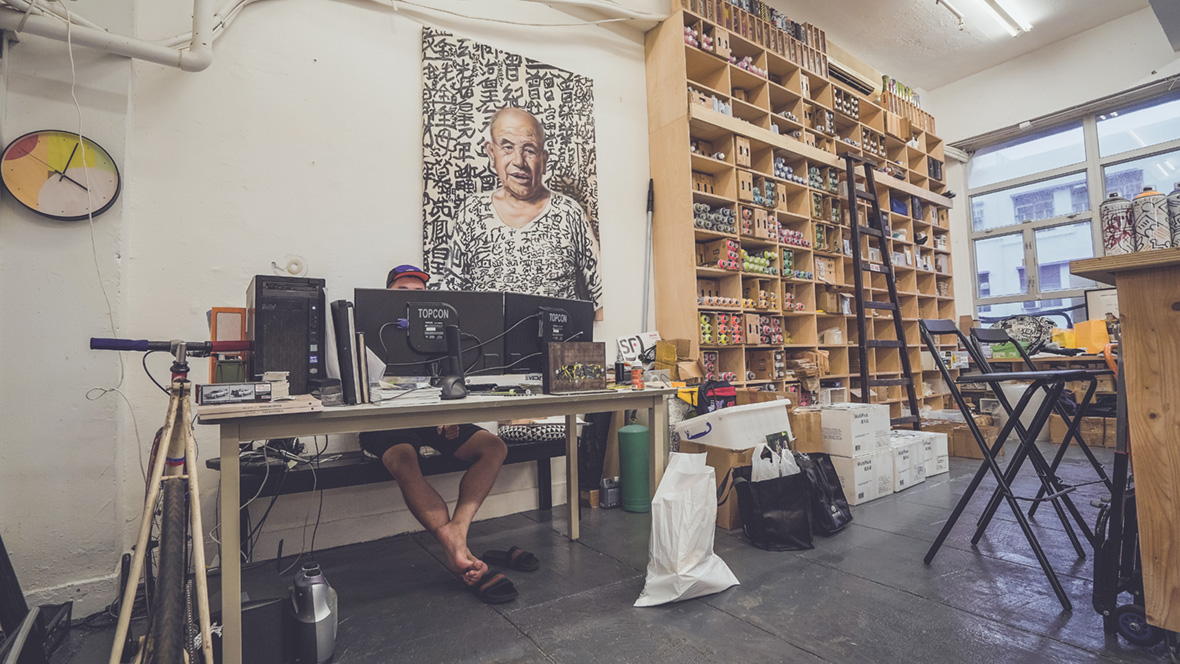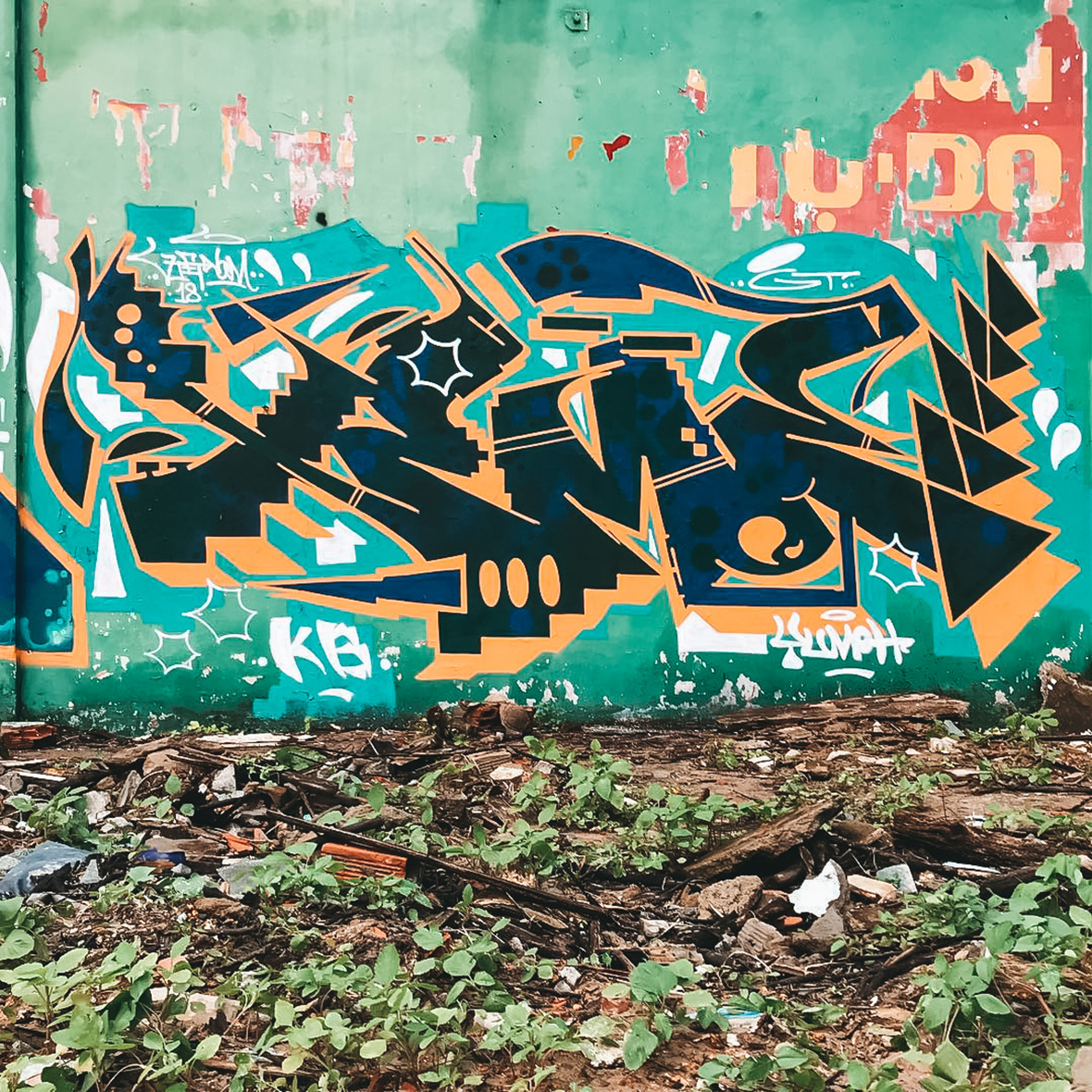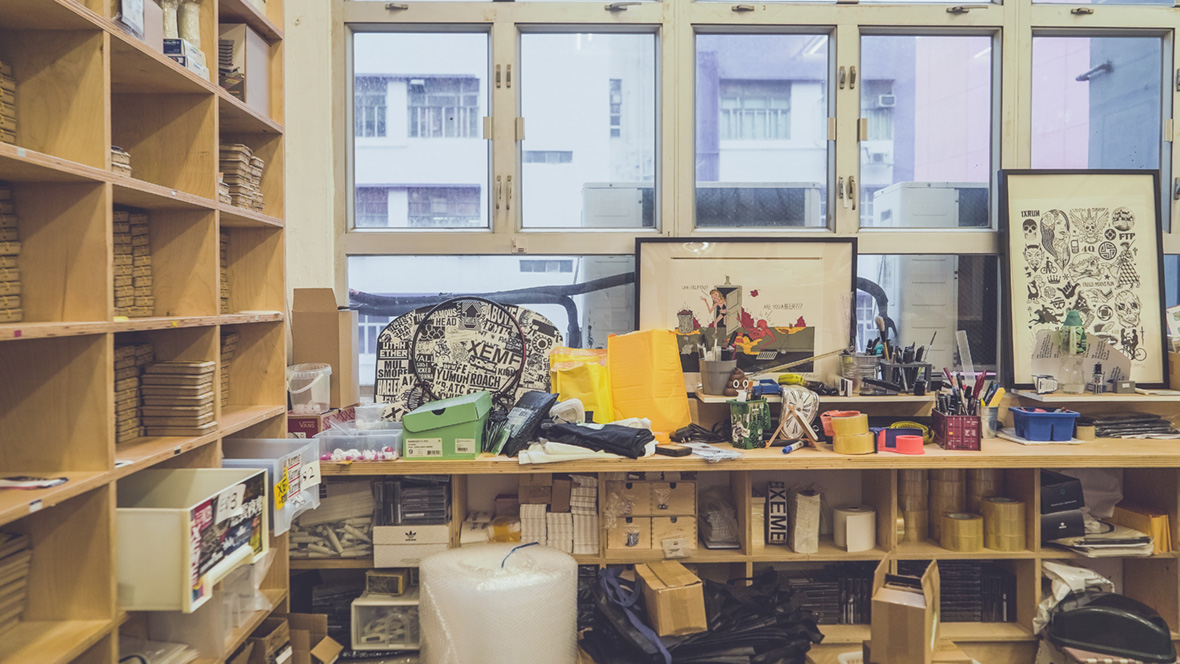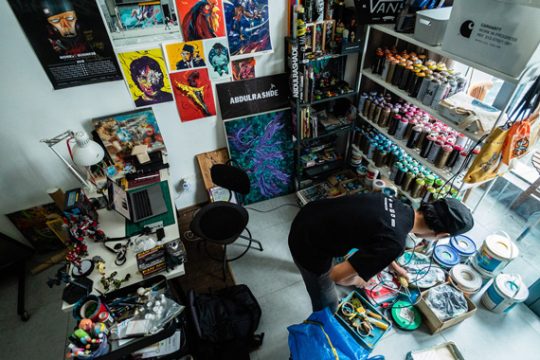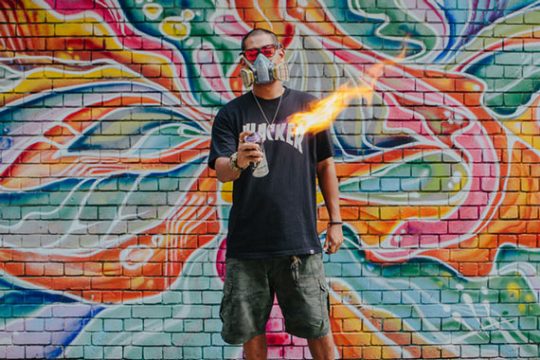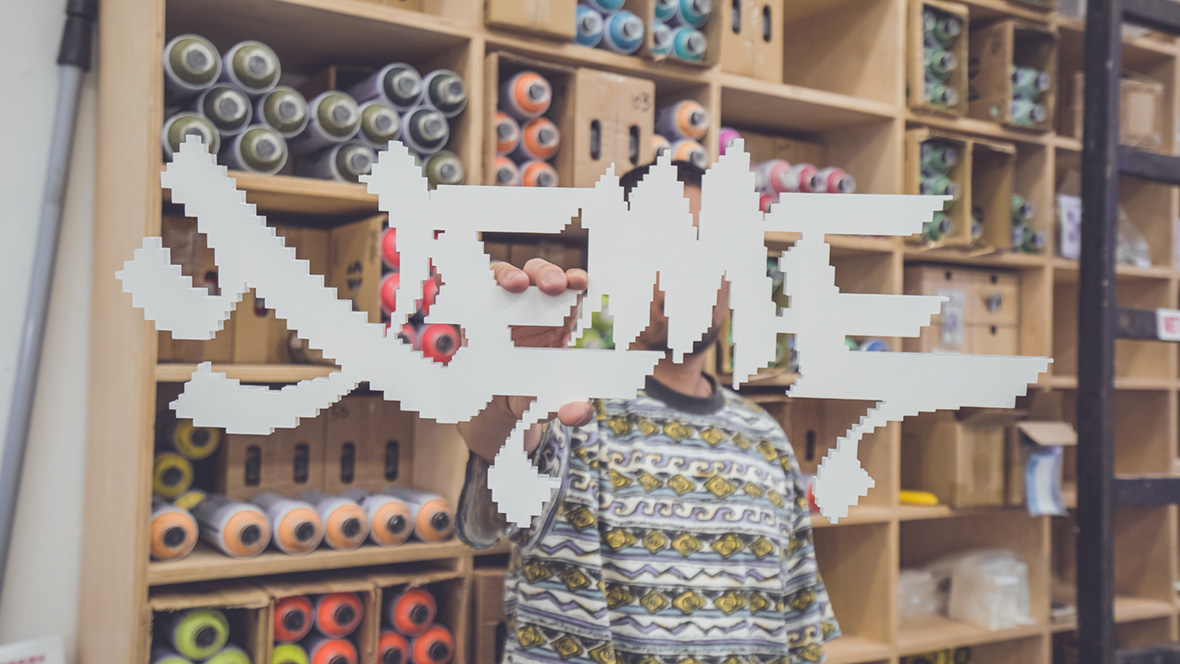
On a wall wedged beneath an elevated subway station and above a major highway, Xeme gets quickly to work painting his blocky, pixelated letters. The white paint absorbs the orange glow of the Hong Kong skyline in the distance, visible here from an angle even locals never see. This is exactly the type of thing he excels at: instantly recognizable letters in high-traffic locations. He’s been one of Hong Kong’s most prominent graffiti writers for close to a decade, someone who’s helped propel the city’s graffiti scene into the international spotlight.
在轻轨站和高速公路的夹层里,Xeme 正专注地在墙上涂鸦着自己的像素块字母。白色的颜料与远方香港天际线的橙色光芒相融,这里是当地人都很少留意到的地方。而 Xeme 极具辨识度的字母涂鸦,就被画在显眼的位置上。Xeme 是近十年来香港最知名的涂鸦艺术家之一,他既是香港城市艺术的受益者,也推动了它在国际上的关注度。
Riding around the city, you see Xeme’s name everywhere. Whether it’s six-foot-tall tags, quickly filled-in bubble letters, or a seemingly endless amount of stickers, it’s impossible to go far without bumping into his work. And while he started out as a vandal, this moonlit pastime has propelled him into the business and art worlds.
在香港这座城市里兜一圈,Xeme 的名字无处不在。无论是六英尺高的签名 tag、快速完成的“泡泡字”(bubble letter)或是看似无穷无尽的贴纸图案,每走过一段距离,就肯定能看到他的作品。虽然,最初涂鸦对他而言只是业余爱好,但在后来他却因为涂鸦而踏入商业和艺术创作的世界。
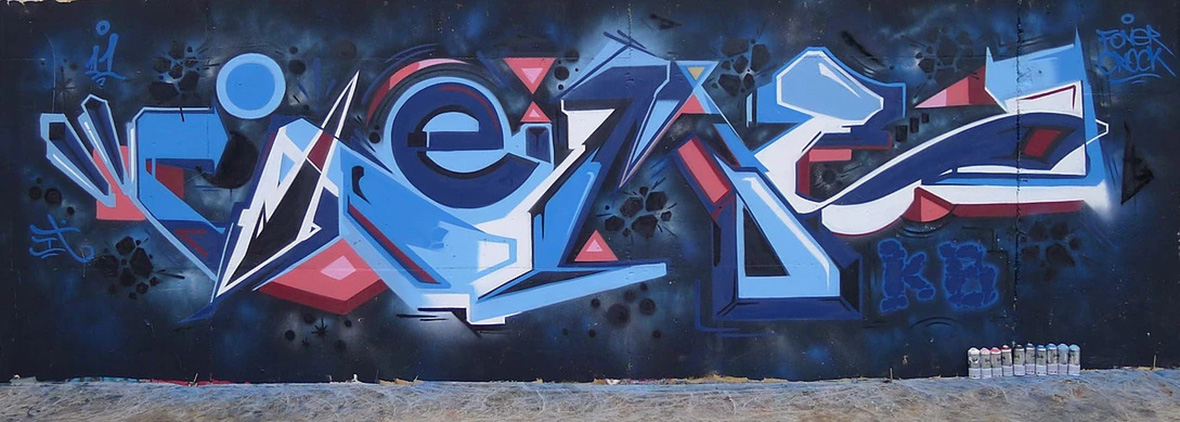
Xeme’s first experience with graffiti was the writing on a trackside wall that he would pass daily as a teenager walking to high school, a sight he would gawk at with awe and wonder. But Hong Kong has never been a city defined by its graffiti, which made learning anything about it very difficult, especially in the early-aughts. At first, he didn’t even know what to call the painted lettering he saw by the tracks. He experimented on hidden walls with tags using an Asian aerosol brand called Pylox, but really had no idea what he was doing.
“I was trying to figure out how to get magazines [about graffiti] and stuff, which was really hard,” Xeme recalls of those early days. “We had no resources, all I could get was the US rap magazine The Source, which had one page of graffiti per issue tucked all the way in the back.” A few years later he met people at a couple of local shops who would travel abroad and bring graffiti supplies back. There was Weed Time, which sold streetwear and did tattoos, and Ashery Clothing, where he met a lot of his crewmates, which sold German-made Belton paint. The internet age arrived not long after, opening Xeme’s eyes to the world at large and providing a global platform for graffiti from Hong Kong.
Xeme 第一次了解涂鸦是高中时期,他每天上学都会经过火车轨道边,那里有一面墙被画满了涂鸦,那让他很受震撼。但在香港,尤其是那些互联网兴起之前的年代,涂鸦并不是特别流行。他起初甚至都不知道该怎么称呼这些画作,更没有途径去学习创作它们。那时他就用亚洲的气溶胶品牌 Pylox 在一些隐蔽的墙上试着创作自己的签名 tag,但他其实也不知道自己到底在做什么。
回忆那些日子,Xeme 说:“我试过去找杂志之类的资料,但真的很难,我们当时根本没有资源。我能找到的只有美国说唱杂志《The Source》,它每一期后面都会有一页涂鸦专题。”几年后,他在当地的商店认识了一些朋友,他们在出国旅行时会帮他带回一些涂鸦用品,包括出售街头服装和做文身的 Weed Time,出售德国 Belton 涂鸦喷漆的 Ashery Clothing,他在那里还遇到了很多志同道合的朋友。在那之后,互联网兴起,Xeme 就在涂鸦的路上越走越远。
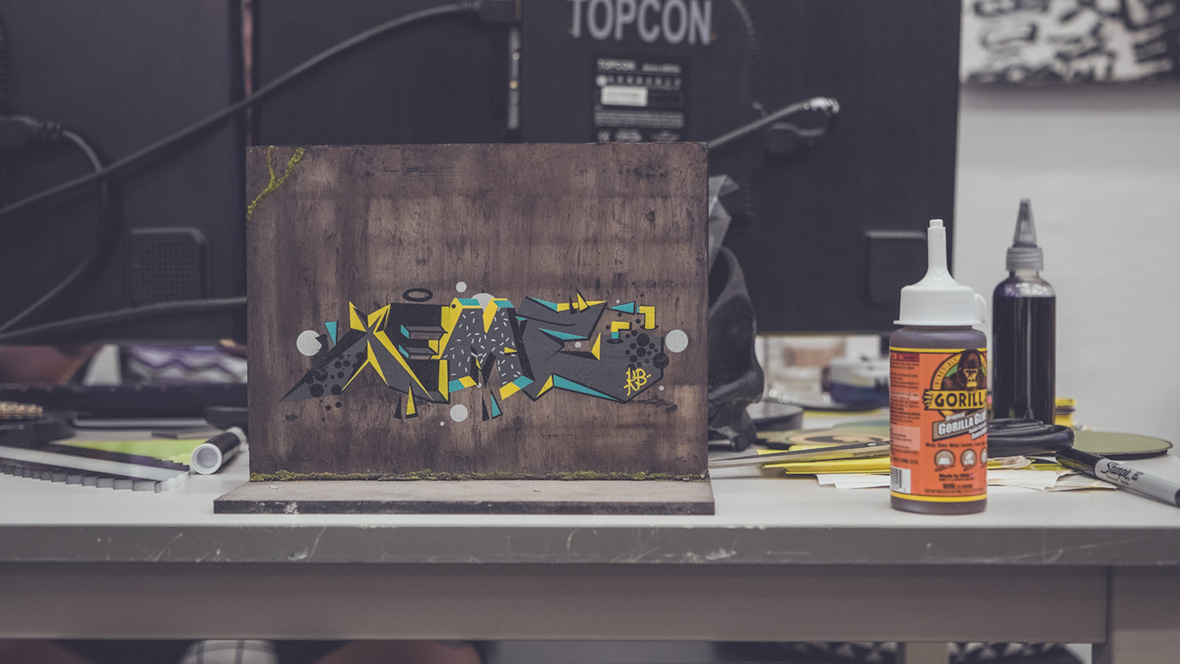
It was tags that Xeme began with, and which he still favors to this day. But it was burners—the colorful and detailed pieces that most of the world can appreciate—that turned him onto art. “I hated art back then, I would sleep during art class,” he laughs of his high school days. “Graffiti just looked cool to me, it was a very juvenile attraction. But as you learn more about it, you get into different fields. Graffiti taught me letters and introduced me to art. Once I got better at burners, art grew on me because that stuff is easier to associate with art. This was maybe ten years later after my start. I’m an art nerd now, and I read books on the Renaissance or Minimalism or Dadaism. Basically covering what I missed in school.”
Xeme 最开始创作的是涂鸦 tag(指“签名”),至今这仍然是他最喜欢的涂鸦风格。但当他接触到 burner(指“精制壁画”)这种大众喜欢,色彩缤纷、细节丰富的作品后,他开始将涂鸦转向艺术方向来创作。“我本来很讨厌艺术,我上艺术课时都会打瞌睡。”他笑着回忆高中时代,“一开始我只是觉得涂鸦看起来很酷,这是一种非常原始的吸引力。但随着你对它的了解加深,你会进入不同的领域。涂鸦让我学会字体创作,引领我走向艺术。当我的 burner 创作得越来越好时,我开始对艺术创作感兴趣,因为这类涂鸦本来就更容易与艺术联系起来。这距离我最初的涂鸦创作已经有十年。现在我成了艺术怪咖,会去读有关文艺复兴、极简主义或达达主义的书。基本上是在弥补我在学校里所遗漏的知识。”
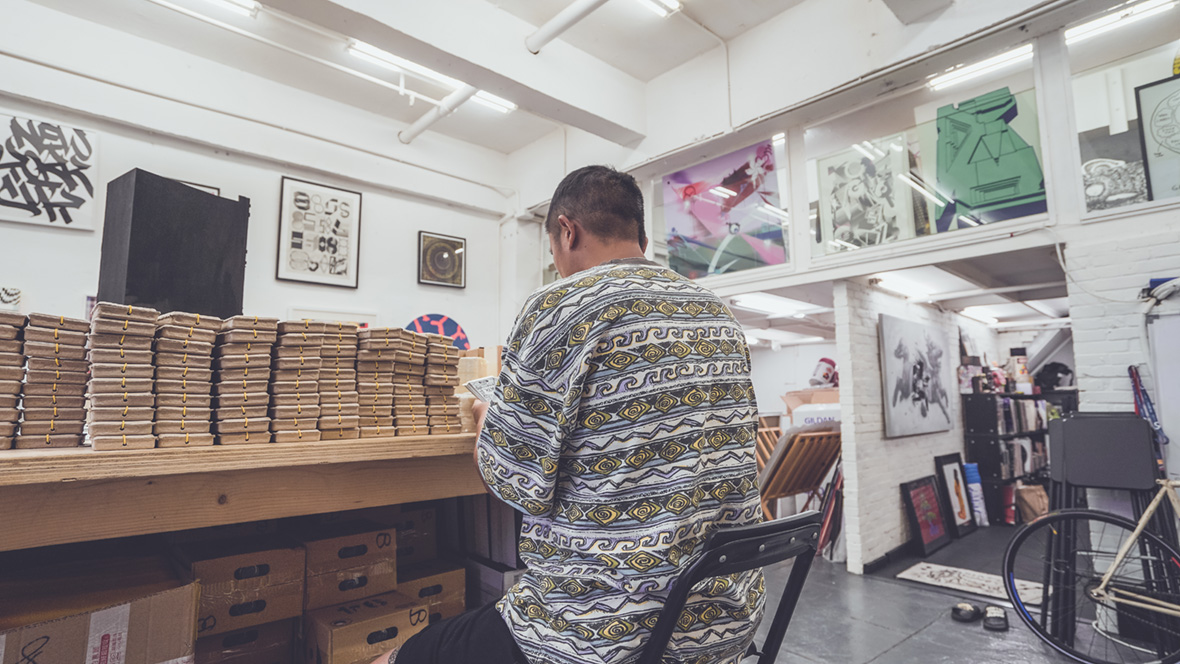
While Xeme may consider himself an art nerd, he’s not too interested in street art. As that scene has grown in popularity, the large murals painted at festivals around the world have become increasingly distanced from their roots. Street art was originally started by graffiti writers who applied their aerosol skills in more commercially viable and accessible ways. But as artists from other walks of life have gotten involved, it’s become more difficult for graffiti writers to participate. It now takes a level of financial investment and professional networking know-how that were rarely necessary in graffiti. And some of graffiti art’s essential aesthetics, particularly the focus on lettering, are also often frowned upon today. As a result, many graffiti writers have turned their backs on what they consider to be a bastardized medium, painting over murals in direct rebellion against the changes they represent. Xeme doesn’t take it that far, but he’s not crazy about the current state of the scene.
虽然自诩艺术咖,但 Xeme 对街头艺术倒没有很大兴趣。随着它的流行,世界各地节日期间绘制的大型墙画已经越来越远离它们的根源。街头艺术最初是由涂鸦作者开始的,他们将喷漆以更可行和更易理解的方式应用在商业上。但随着其他行业的艺术家参与进来,传统涂鸦作家的参与变得越来越困难。现在街头艺术的门槛变得更高,甚至需要一定程度的金融投资和专业人脉,这在涂鸦中是很少需要的。一些涂鸦艺术的基本美学,特别是对字体的关注,在今天也经常遭到反对。因此许多涂鸦作家抛弃了他们认为已变劣质的媒介,直接在墙壁上画涂鸦,盖过之前的作品,以作为反抗。虽然 Xeme并没有走那么远,但他对现在的街头艺术圈不感兴趣。

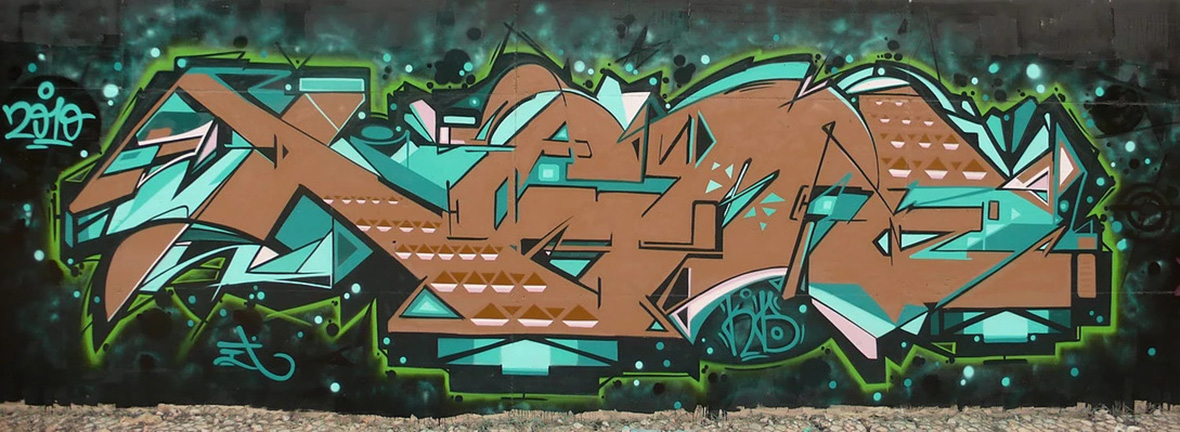
“Street art wouldn’t exist if it weren’t for graffiti, so it still has a very important role,” he says. “Many of the artists leading the movement have strong graffiti backgrounds, and the street art with graffiti elements in it is what really catches my attention.” But overall, he just focuses on his own passions.
Graffiti also led to much of his business opportunities. He runs a sticker company called Egg Shell that’s globally renowned, and he helps get spray paint into shops across Asia. “I give all the credit to my city,” he says. “The fact that they don’t paint over much in the city means my name runs forever. And there’s so much room to paint here. There’s not much competition, either. My career is entirely thanks to my city and mostly to graffiti.”
“如果没有涂鸦,就不会有街头艺术,所以涂鸦仍然具有非常重要的作用。”他说,“在这场变革中,许多带头的艺术家都有强烈的涂鸦背景,带有涂鸦元素的街头艺术才真正是我感兴趣的。”但总体而言,他只是专注于自己的热情所向。
涂鸦也为他带来了大量商业合作机会。他现在经营着一个名为 Egg Shell 的全球知名贴纸公司,并帮助亚洲各地的商店获取涂鸦喷漆。“我要感谢香港这座城市。没有人遮盖我的作品,这意味着我的名字可以一直放在那。而且,在这里有很多地方可以涂鸦,也没有太多的竞争。在工作方面,我既要感谢香港这座城市,更要感谢涂鸦。”
Like our stories? Follow us on Facebook and Instagram.
Website: www.xeme.co
Instagram: @xememex
Contributor: Mike Steyels
Photographer: Mart Sarmiento
Additional Images Courtesy of Xeme


